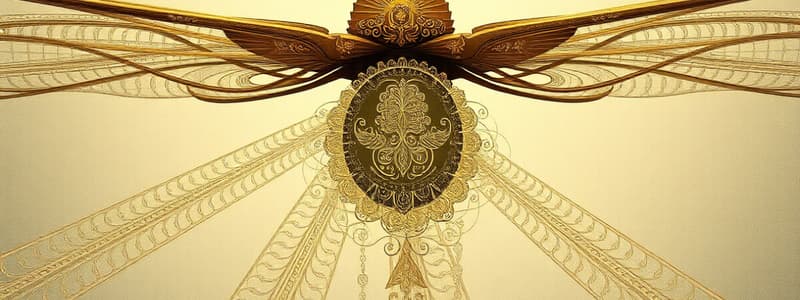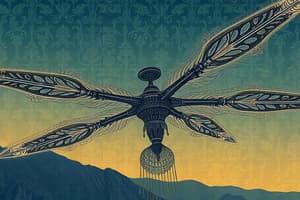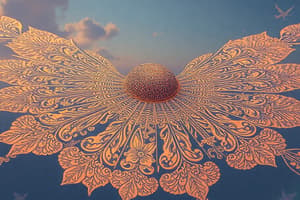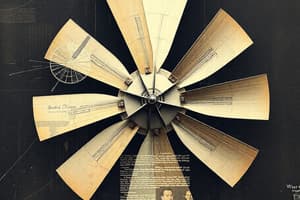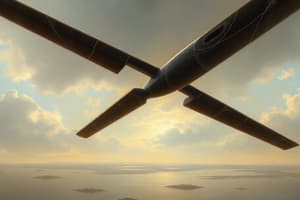Podcast
Questions and Answers
Which rotor blade design is known for producing greater lift for the same surface area?
Which rotor blade design is known for producing greater lift for the same surface area?
- Tapered
- Asymmetrical (correct)
- Parallel
- Symmetrical
What is the primary reason symmetrical rotor blades are more commonly used?
What is the primary reason symmetrical rotor blades are more commonly used?
- They are easier to repair
- They are cheaper to manufacture
- They have a more stable aerodynamic characteristic (correct)
- They produce more lift
What is a key characteristic of a uniform planform rotor blade?
What is a key characteristic of a uniform planform rotor blade?
- It requires multiple different rib part numbers
- The leading and trailing edges converge
- The leading and trailing edges run parallel to each other (correct)
- The chord length decreases towards the tip
Why do manufacturers often prefer to produce uniform planform rotor blades?
Why do manufacturers often prefer to produce uniform planform rotor blades?
What is the purpose of negative twist on a rotor blade?
What is the purpose of negative twist on a rotor blade?
Which of the following is NOT a typical material used in the construction of helicopter rotor blades?
Which of the following is NOT a typical material used in the construction of helicopter rotor blades?
What is a key advantage of using bonded construction in rotor blades?
What is a key advantage of using bonded construction in rotor blades?
During the inspection of composite rotor blades, which method is often considered primary?
During the inspection of composite rotor blades, which method is often considered primary?
What is the purpose of the stainless steel capping on the leading edge of rotor blades?
What is the purpose of the stainless steel capping on the leading edge of rotor blades?
Where are spanwise balance weights typically located on a rotor blade?
Where are spanwise balance weights typically located on a rotor blade?
Why are the bottom surfaces of rotor blades typically painted matte black?
Why are the bottom surfaces of rotor blades typically painted matte black?
Where is the chordwise mass balance weight typically located on a rotor blade?
Where is the chordwise mass balance weight typically located on a rotor blade?
If weight is added to the trailing edge of a rotor blade, how would this typically affect the plane of rotation?
If weight is added to the trailing edge of a rotor blade, how would this typically affect the plane of rotation?
Which of the following must be done before rigging a hydraulic system on a helicopter?
Which of the following must be done before rigging a hydraulic system on a helicopter?
Which of the following is the correct order of rigging for helicopter controls?
Which of the following is the correct order of rigging for helicopter controls?
What is the function of the servo flap on a helicopter rotor blade?
What is the function of the servo flap on a helicopter rotor blade?
Flashcards
Tap testing
Tap testing
A method of inspecting composite rotor blades that involves tapping the surface to detect delamination or other internal damage.
Double plates
Double plates
Additional plates located at the root of the blade tip, designed to increase structural strength without adding weight.
Balance weights
Balance weights
Weights strategically placed on the rotor blade to balance its mass distribution, ensuring smooth and stable flight. These weights can be spanwise, chordwise, or tracking.
Trim tab
Trim tab
Signup and view all the flashcards
Rigging
Rigging
Signup and view all the flashcards
Correlator
Correlator
Signup and view all the flashcards
Autorotational check
Autorotational check
Signup and view all the flashcards
Servo flap
Servo flap
Signup and view all the flashcards
Symmetrical Rotor Blade
Symmetrical Rotor Blade
Signup and view all the flashcards
Asymmetrical Rotor Blade
Asymmetrical Rotor Blade
Signup and view all the flashcards
Parallel (Uniform) Planform
Parallel (Uniform) Planform
Signup and view all the flashcards
Tapered Planform
Tapered Planform
Signup and view all the flashcards
Negative Twist Blade
Negative Twist Blade
Signup and view all the flashcards
Bonded Construction
Bonded Construction
Signup and view all the flashcards
Single Pocket Construction
Single Pocket Construction
Signup and view all the flashcards
Multi Pocket Construction
Multi Pocket Construction
Signup and view all the flashcards
Study Notes
Rotor Blade Designs
- Symmetrical blades have better aerodynamic pitch characteristics, while asymmetrical blades produce greater lift for the same surface area. Asymmetrical designs have higher camber on one side, and engineers achieve similar pitching characteristics by sweeping the edges. Symmetrical designs are more common due to the instability of asymmetrical designs.
- Blade planforms can be parallel (uniform) or tapered. Uniform blades have parallel leading and trailing edges, creating greater lift because of the chord line. Manufacturers prefer uniform designs for cost-effectiveness, using only one rib part number. Tapered blades converge towards the edges and have decreasing chord lengths, improving lift distribution, but requiring multiple rib numbers. Tapered designs account for speed variation, with negative twist used to provide higher angles of attack at the rotor root, while maintaining similar lift at the blade tip (uniform planforms).
- Construction types include bonded construction, which is stronger and more durable than others without drilling holes. Single-pocket designs are quicker to manufacture, while the multi-pocket design offers better repair if damaged.
- Trim balance weights (two per blade) affect the rotor blade's flight characteristics. Adding weight forward lowers the flight path, and backward raises it. Erosion protection from small particles is common using stainless steel capping on leading edges
- Rotor blade materials can be composite, metal, or wood. Matte black paint is often used to reduce glare.
Balance Weights and Hydraulics
- Spanwise balance weights are located at the blade tip center.
- Chordwise mass balance weights are positioned near the leading edge (30-50% of the blade span).
- Tracking weights (one on the leading edge and one on the trailing edge of the span line) affect the flight path.
- Trim tabs (easier to adjust than tracking weights, located near the trailing edge, ~75% of the span) can be used to adjust pitch, using velocity of airflow to achieve the desired aerodynamic effect.
- Rigging and servicing should include disconnecting hydraulics to ensure all pressure is removed. Collective is rigged first; connected to throttle to control lift.
- Servo flaps (near the trailing edge) are used to reduce the reliance on hydraulics, enabling simple hub maintenance. Simplified hydraulic systems improve helicopter performance and reliability.
Studying That Suits You
Use AI to generate personalized quizzes and flashcards to suit your learning preferences.
